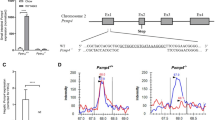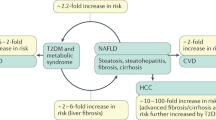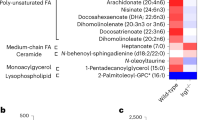Abstract
Several drugs, including clofibrate (ethyl-a-p-chlorophenoxyisobutyrate)1, are now available for the treatment of hyperlipidaemias2,3 and others are in the process of preclinical or clinical evaluation4,5. Clofibrate, the most widely used hypo-lipidaemic drug in Europe and the US2, as well as other potent hypolipidaemic agents, cause massive hepatomegaly when administered to rats6–8, mice7,8 or hamsters (J.K.R., unpublished). This hepatomegaly is characteristically associated with a marked increase of peroxisomes (Fig. 1) in the liver cells of all three species6–8. These ubiquitous cytoplasmic organelles9,10contain catalase, several hydrogen peroxide-generating oxi-dases, carnitine acetyltransferase11 as well as enzymes involved in the β-oxidation of long-chain fatty acids12. The activities of these enzymes in liver are elevated in association with peroxisome proliferation8,13. As hepatomegaly and peroxisome proliferation persist for as long as these drugs are administered to the animals, we initiated chronic toxicity studies with selected hepatic peroxisome proliferators in CSb mice and F344 rats. Liver tumours were observed in both rats and mice fed nafeno-pin (2-methyl-2[p-(l,2,3,4-tetrahydro-l-naphthyl)phenoxy]-propionic acid)14–16 or Wy-14,643 ([4-chloro-6-(2,3-xylidino)-2-pyrimidinylthio]acetic acid)17, two structurally unrelated compounds (Fig. 2, compounds 2 and 3) which are several times more potent than clofibrate in inducing peroxisome proliferation and hypolipidaemia8. Recent evidence indicates that clofibrate (Fig. 2, compound 1) is also carcinogenic when fed to rats at a concentration of 0.5% in the diet18,19. We report here that BR-931 ([4-chloro-6-(2,3-xylidino)-2-pyrimidinylthio(N-β-hydroxyethyl)-acetamide])20 and tibric acid(2-chloro-5-(3,5-dimethylpiperidinosulphonyl)benzoic acid)8, two potent hypolipidaemic hepatic peroxisome proliferators (Fig. 2, compounds 4 and 5) induce hepatocellular carcinomas in CSb mice and/or F344 rats. Thus, the development of liver tumours, in animals fed five structually diverse hypolipidaemic compounds (Fig. 2) supports our hypothesis that potent hepatic peroxisome proliferators as a class are carcinogenic.
This is a preview of subscription content, access via your institution
Access options
Subscribe to this journal
Receive 51 print issues and online access
$199.00 per year
only $3.90 per issue
Buy this article
- Purchase on Springer Link
- Instant access to full article PDF
Prices may be subject to local taxes which are calculated during checkout
Similar content being viewed by others
References
Thorp, J. M. & Waring, W. S. Nature 194, 948–949 (1962).
Havel, J. F. & Kane, J. P. A. Rev. Pharmac. 13, 291–300 (1973).
Sirtori, C. R., Catapano, A. & Paoletti, R. Atherosclerosis Rev. 2, 113–153 (1977).
Bencze, W. L. in 6th Int. Symp. on Drugs Affecting Lipid Metabolism, Philadelphia 1977 (eds Kritchevsky, D., Paoletti, R. & Holmes, W. L.) 77–95 (Plenum, New York, 1978).
Paoletti, R., Fumagalli, R. & Sirtori, C. R. Int. Conf. Atherosclerosis. Milan (1977).
Hess, R., Stäubli, W. & Reiss, W. Nature 208, 856–858 (1965).
Svoboda, D., Grady, H. & Azarnoff, D. J. Cell Biol. 35, 127–152 (1967).
Reddy, J. K. & Krishnakantha, T. P. Science 190, 787–789 (1975).
Hruban, E., Vigil, E. L., Slesers, A. & Hopkins, E. Lab. Invest. 27, 184–191 (1972).
Novikoff, A. B., Novikoff, P. M., Davis, E. & Quintana, N. J. Histochem. Cytochem. 21, 737–755 (1973).
Masters, C. & Holmes, R. Physiol. Rev. 57, 816–882 (1977).
Lazarow, P. B. & DeDuve, C. Proc natn. Acad. Sci. U.S.A. 73, 2043–2046 (1976).
Osumi, T. & Hashimoto, T. J. Biochem. 85, 136–139 (1979).
Reddy, J. K., Rao, M. S. & Moody, D. E. Cancer Res. 36, 1211–1217 (1976).
Reddy, J. K. & Rao, M. S. J. natn. Cancer Inst. 59, 1645–1650 (1977).
Reddy, J. K. & Rao, M. S. Science 198, 78–80 (1977).
Reddy, J. K. & Rao, M. S., Azarnoff, D. L. & Sell, S. Cancer Res. 39, 152–161 (1979).
Reddy, J. K. & Qureshi, S. A. Br. J. Cancer. (in the press).
Svoboda, D. J. & Azarnoff, D. L. Cancer Res. 39, 3419–3428 (1979).
Reddy, J. R., Azarnoff, D. L. & Sirtori, C. R. Archs int. Pharmacodyn. Ther. 234, 4–14 (1978).
Farber, E. Cancer Res. 33, 2537–2550 (1973).
Warren, J. R., Simmon, V. F. & Reddy, J. K. Cancer Res. (in the press).
Allison, A. C. & Paton, G. R. Nature 207, 1170–1173 (1965).
Author information
Authors and Affiliations
Rights and permissions
About this article
Cite this article
Reddy, J., Azarnoff, D. & Hignite, C. Hypolipidaemic hepatic peroxisome proliferators form a novel class of chemical carcinogens. Nature 283, 397–398 (1980). https://doi.org/10.1038/283397a0
Received:
Accepted:
Issue Date:
DOI: https://doi.org/10.1038/283397a0
This article is cited by
-
Peroxisomal compartmentalization of amino acid biosynthesis reactions imposes an upper limit on compartment size
Nature Communications (2023)
-
Prognostic role of PHYH for overall survival (OS) in clear cell renal cell carcinoma (ccRCC)
European Journal of Medical Research (2021)
-
Recent updates on phthalate exposure and human health: a special focus on liver toxicity and stem cell regeneration
Environmental Science and Pollution Research (2018)
-
E2/ERβ Inhibits PPARα to Regulate Cell-Proliferation and Enhance Apoptosis in Hep3B-Hepatocellular Carcinoma
Pathology & Oncology Research (2017)
-
Analysis of gene expression changes in relation to hepatotoxicity induced by perfluorinated chemicals in a human hepatoma cell line
Toxicology and Environmental Health Sciences (2016)
Comments
By submitting a comment you agree to abide by our Terms and Community Guidelines. If you find something abusive or that does not comply with our terms or guidelines please flag it as inappropriate.



